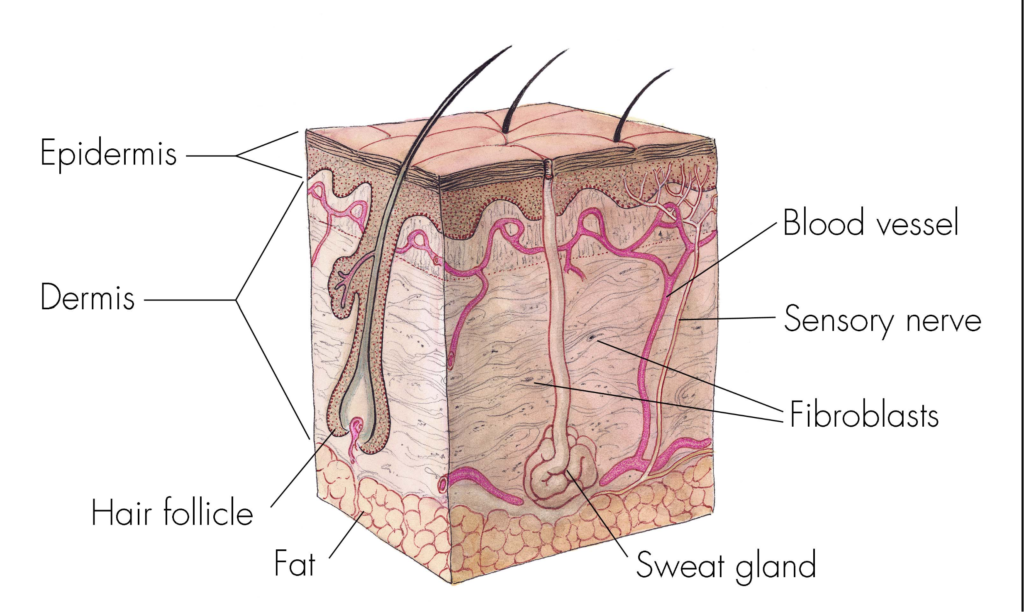The sense of touch is one of the most important and complex senses that humans have. It allows us to perceive and interact with the physical world, as well as to communicate and express emotions. Touch is also essential for our survival, as it helps us to avoid harm and to maintain our body temperature and balance. But how does touch work? How do we feel the objects that we touch with our fingers?
The answer is not as simple as it may seem. The outer layer of skin cells on our finger does not detect anything by itself. In fact, the outer layer of our skin, called the epidermis, is mostly made of dead cells that serve as a protective barrier against water loss, infection, and injury. The epidermis has no blood vessels, nerves, or sensory receptors. Therefore, it cannot sense any physical stimuli, such as pressure, temperature, or pain1
The sensation of touch is actually detected by specialized nerve endings that are located in the deeper layer of our skin, called the dermis. The dermis contains various types of sensory receptors that respond to different kinds of stimuli, such as mechanical, thermal, or chemical. These receptors are connected to nerve fibers that transmit the signals to the spinal cord and the brain, where they are processed and interpreted1
Also read : Ice Crisis: Five Times Faster Greenland Glacier Melting Than Twenty Years Ago
Some of the most common types of sensory receptors in the skin are:

- Mechanoreceptors: These receptors respond to mechanical stimuli, such as pressure, vibration, stretch, or touch. They are responsible for sensing the shape, texture, and movement of the objects that we touch, as well as our own body position and movement. There are four main types of mechanoreceptors in the skin: Merkel cells, Meissner’s corpuscles, Ruffini endings, and Pacinian corpuscles. Each type has a different structure, location, and function2
- Merkel cells: These are oval-shaped cells that are found in the epidermis, especially in the fingertips, lips, and genitals. They are attached to nerve endings that form a disk-like structure called a Merkel disk. They are sensitive to light touch and pressure, and can detect fine details and textures. They are also slow-adapting, meaning that they continue to fire as long as the stimulus is present
- Meissner’s corpuscles: These are oval-shaped structures that are found in the dermal papillae, which are the projections of the dermis that interlock with the epidermis. They are abundant in hairless areas of the skin, such as the fingertips, palms, soles, lips, and eyelids. They are sensitive to light touch and vibration, and can detect changes in the shape and movement of the objects that we touch. They are also fast-adapting, meaning that they fire only when the stimulus changes
- Ruffini endings: These are spindle-shaped structures that are found in the deeper layers of the dermis and the subcutaneous tissue. They are distributed throughout the body, but are more concentrated in the fingers, palms, and soles. They are sensitive to stretch and pressure, and can detect the shape and size of the objects that we touch, as well as the direction and speed of our finger movement. They are also slow-adapting, meaning that they continue to fire as long as the stimulus is present2
- Pacinian corpuscles: These are onion-shaped structures that are found in the deeper layers of the dermis and the subcutaneous tissue. They are distributed throughout the body, but are more concentrated in the fingers, palms, soles, joints, and internal organs. They are sensitive to deep pressure and vibration, and can detect the intensity and frequency of the stimuli. They are also fast-adapting, meaning that they fire only when the stimulus changes2
- Thermoreceptors: These receptors respond to thermal stimuli, such as heat and cold. They are responsible for sensing the temperature of the objects that we touch, as well as our own body temperature. There are two main types of thermoreceptors in the skin: warm receptors and cold receptors. Each type has a different threshold and range of sensitivity3
- Warm receptors: These are free nerve endings that are found in the dermis, especially in the trunk and limbs. They are activated by temperatures above 30°C (86°F) and reach their maximum response at 45°C (113°F). They are also slow-adapting, meaning that they continue to fire as long as the stimulus is present3
- Cold receptors: These are free nerve endings that are found in the epidermis and the dermis, especially in the face and hands. They are activated by temperatures below 35°C (95°F) and reach their maximum response at 20°C (68°F). They are also fast-adapting, meaning that they fire only when the stimulus changes3
- Nociceptors: These receptors respond to noxious stimuli, such as pain and itch. They are responsible for sensing the damage or potential damage to the skin and the underlying tissues, as well as the presence of irritants or allergens. There are three main types of nociceptors in the skin: mechanical nociceptors, thermal nociceptors, and chemical nociceptors. Each type has a different threshold and specificity4
- Mechanical nociceptors: These are free nerve endings that are found in the epidermis and the dermis. They are activated by intense pressure, puncture, or cutting of the skin. They are also fast-adapting, meaning that they fire only when the stimulus changes4
- Thermal nociceptors: These are free nerve endings that are found in the epidermis and the dermis. They are activated by extreme temperatures, above 45°C (113°F) or below 15°C (59°F). They are also fast-adapting, meaning that they fire only when the stimulus changes4
- Chemical nociceptors: These are free nerve endings that are found in the epidermis and the dermis. They are activated by various chemicals, such as acids, bases, capsaicin, histamine, or serotonin. They are also slow-adapting, meaning that they continue to fire as long as the stimulus is present4

So, how does the outer layer of skin cells on our finger detect when we are touching an object? The answer is that it does not. It is the sensory receptors in the lower layer of our skin that detect the physical stimuli and send the signals to our brain, where we perceive the sensation of touch. The outer layer of skin cells is just a passive barrier that protects the inner layer and the receptors from the external environment. Therefore, when we touch an object, we are actually touching it with our nerves, not with our skin. 1
Also read: The Brutal Fury Of Mount Etna: Towering Ash And Lava Eruptions Across Sicily




































